
An office lease agreement is a legal document between a landlord who rents office space to a tenant for payment. Commonly, the tenant will pay the landlord on a monthly basis for the use of the office space, including amenities, services, and utilities.
An office lease agreement is a legal document between a landlord who rents office space to a tenant for payment. Commonly, the tenant will pay the landlord on a monthly basis for the use of the office space, including amenities, services, and utilities.
PDF Download
An office lease agreement is a legal document between a landlord who rents office space to a tenant for payment. Commonly, the tenant will pay the landlord on a monthly basis for the use of the office space, including amenities, services, and utilities.
4.5 | 119 Ratings Downloads: 7,276
Commercial Lease Application – It is recommended for a landlord to screen a tenant prior to signing a lease.
The term of a lease (start and end dates) is one of the most important parts of an office lease. For smaller spaces (less than 2,000 SF), it is common for a lease to be 1 to 2 years. For larger spaces, it is common for the tenant to want a commitment for 3 to 5 years.
Options to Renew – A tenant may request an option to renew the lease at predetermined rent increases. It is common for a renewal period to increase rent based on the Bureau of Labor Statistics Consumer Price Index (CPI).
The rent usually consists of 2 items:
Security Deposit – A tenant is commonly required to pay a security deposit, equal to 1 month’s rent, in the event the tenant does not fulfill their obligations in the lease.
Restricts a tenant from using the space for anything except for office-related activity. With office space, it is common for restrictions to be made in the lease to maintain quiet enjoyment for the other tenants.
Common use restrictions include:
A landlord can deliver office space in 3 ways:
Landlords commonly offer amenities, included in the rent, to entice tenants. Some of these include:
Subletting is commonly prohibited in office lease agreements. Landlords generally prefer to approve and reject every tenant to maintain the continuity of a property.
Allowing the tenant to rent the office space to someone else is not preferred unless the tenant undergoes financial hardship.
To allow a tenant to perform construction and build out the office space. This usually requires the tenant to revert the space to its original condition if it’s not the landlord’s preference.
It is commonly required for tenants with low credit scores to have another individual guarantee the lease. This is done by attaching a lease guarantor form.